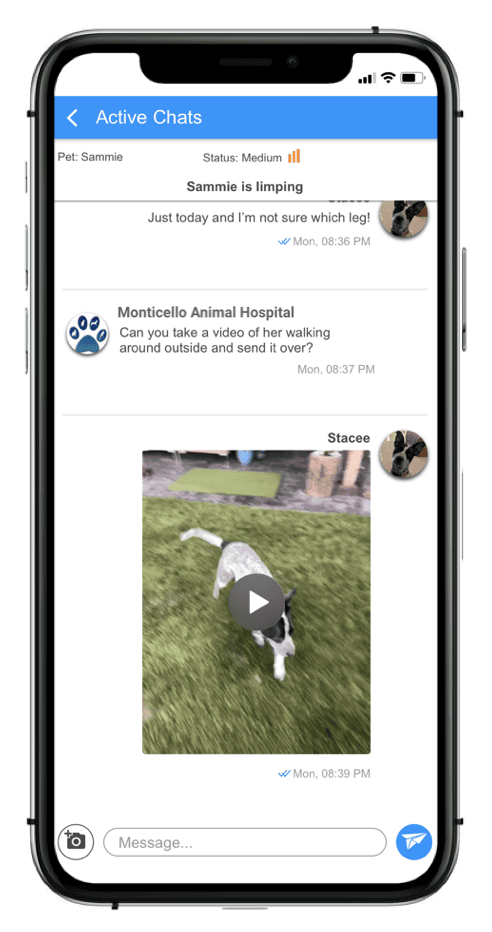We’ve all been in this scenario: The pet owner has rushed their dog in for choking. On a “concerned scale,” they are a 10 out of 10, but by the time they get there, Fido is happy as a clam and ready to slather you with a big slobbery kiss. After a detailed history, and a re-enactment worthy of an academy award, you determine the most likely cause is a reverse sneeze.
Meet asynchronous video! Imagine: Instead of rushing to the clinic in a mad panic, your client could capture the event on video from their mobile device, and shoot it over to you via your practice’s app. After a quick view, you can easily let the owner know this is a simple reverse sneeze, and a spoonful of honey (or peanut butter) should alleviate any future attacks.
Pet owner win:
- A rapid response minimizes the stress of thinking this is “the big one”
- Saved exam fee
- Increased value of having an established relationship with you
Practice win:
- Helping provide quick care to your client and minimize their stress
- One less appointment to “work in”
- Avoided reverse sneeze re-enactment
While live video calls have their place on occasion (like old dog vestibular syndrome or active seizure), asynchronous videos are often more useful, and more efficient, for providers. With Vet2Pet’s 2-Way Chat feature, your client can send you a video demonstrating their pet’s condition at the height of the problem, and the video will be stored in the cloud for future reference.
As we strive to make the lives of veterinarians and their teams easier, and their practices more efficient, through our Vet2Pet app features, we’ve highlighted some of the top benefits of asynchronous video versus live video. Check out these four ways asynchronous video may make more sense for you compared to live video streaming.
1: Avoid wasting time while the pet owner is trying to catch the pet in action
How many times have you taken multiple pictures or videos to capture that perfect selfie of you and your pet? It’s tough, and the proof is in your phone’s trash bin. Your client probably has dozens of “outtakes” on their phone, as they struggle to catch their pet’s limp, cough, or vague “weakness episodes.” As a veterinarian, you wait patiently as the pet owner scrambles to wrangle their wily pet into the camera frame. Their 15-minute appointment slot is ticking away, and all you’ve seen is a blurry tail and wrestling moves that would put The Rock to shame. At the end of the scheduled appointment time, you still haven’t seen the presenting issue, and you, your client, and your patient are exasperated.
Enter asynchronous video. Your client films a quick video that beautifully highlights your patient’s limp first thing in the morning, or their weird rattling breath heard only when sleeping. They send you the short video, and you’re able to spend their appointment time discussing a potential diagnosis and treatment options.
“Our experience so far is that live video is really hard,” said Vet2Pet user Practice Manager Stephanie Goss. “Trying to get them to wrangle with the pet and back them up, or zoom in enough to see what we need, has been messy. We’ve been using uploaded video and guided questions and directions to obtain additional video far more successfully.”
Getting a pet to demonstrate an illness or injury on command during a live video is like asking a car to make that strange ticking noise for the mechanic on command. By avoiding the hassle with a live video call, you can save yourself time and your clients money by looking at a perfectly clear video or picture sent through Vet2Pet’s 2-Way Chat.
2: Gain clarity and options with asynchronous video over live video
Similar to verbal versus written information, live video does not allow you to go back over information like you can with a recorded video. With asynchronous video, you can pause, zoom in, and rewatch certain portions of the video, and gain vital information about a pet’s condition that you may otherwise miss. You can also discuss particular areas of the recording with the pet owner to gain more clarification, or to help educate them. For example, you might say, “I know you had mentioned Fido seemed to snap at your other dog without warning, but if you look closely at 33 seconds into the video, you’ll notice Fido’s furrowed brow, whale-eyed appearance, and sudden stiffening of his body, which are all warning signals in dog language.” With a live video, using these visual cues to educate your client would be impossible.
3: Multitask with asynchronous video

The beauty of asynchronous video means you don’t have to sit through a live video for each client. Instead, have your telemedicine clients send you recorded videos, which you can watch and respond to in minutes through our 2-Way Chat feature. Rather than carving out 15-minute chunks for each live video that offers only seconds of usable content, you can whiz your way through your entire virtual workload in the time it would normally take one live video appointment. Not only can you “see” more patients in a short amount of time, but you can also evaluate their issues simultaneously, or you can ask a client to send a video while you see a patient in-person in your exam room. Multitasking = more patients seen = higher revenue generation, and getting home for dinner on time.
4: You won’t get stuck on a video call with a pet owner
Do you have chatty Kathy clients? While you love connecting with your clients and deepening your bond, sometimes you have to move along to your other waiting appointments, and can’t shoot the breeze any longer. With asynchronous video, you can have your client send a video while you see in-clinic appointments, and then jump back on 2-Way Chat in your free moments. Live video can’t save you from those pet owners who ask, “While I’ve got you here, can I ask you a quick question? My cat isn’t using the litter box…” ARGH!! But, with recorded videos, you’re free to bounce in and out of those virtual appointments.
Do you prefer recorded videos over live calls? Visit the Vet2Pet page for more info.



